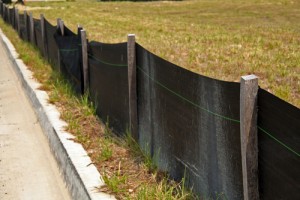A silt fence is a staple of the construction industry. It falls under the category of geotextiles and is used for erosion control by trapping sediment and preventing excessive runoff. It’s commonly used for these applications because it’s both low-cost, and easy to maintain. However, it’s also common for silt fences to be ineffective due to improper installation. With that in mind, here are some tips for choosing the right silt fence for the job and installing it correctly.
- Height
The height of the fabric of your silt fence depends on the slope of the site. On a generally flat site, which would be one with less than a six percent slope, a 16-inch height should be effective. Taller silt fences are required when the slope increases, however. But, there is a limit for how tall a fence should be. Never exceed 28-inches because this introduces the possibility of flooding below the fence if it should fail. Your fence should be just tall enough to make up for installing it on the contour of a steeper slope.
- Post type
While there are alternatives available, wood posts have proven to be the most reliable and effective for silt fence installations. They feature large cross sectional areas, which help to resist side loads, and fabric can easily be attached securely with wide crown staples. This is a better option than using zip ties, or wire ties with t-posts. Wood posts also limit the possibility that fabric is torn in heavy winds. T-posts have their place, however. In certain applications when the soils are so hard or rocky that wood posts can’t be installed, t-posts are an acceptable substitute.
- Post spacing
In order to significantly improve the strength of a silt fence, you can simply cut down the space between each post. A general rule of thumb is that 10-feet is the maximum distance acceptable between posts. There are no applications where more distance is acceptable, but many applications when less space is needed. Low areas and turns, for example, require posts with less space between them. To ensure your silt fence will stand up to winds, water runoff and other stresses, installing posts at 8-feet apart is recommended. In fact, the additional cost of more posts is often off-set by the lower cost of required maintenance throughout the life of the silt fence.
- Post length
When it comes to post length, one-size almost always fits all. For the typical application in the Midwest, post lengths should be 16-inches longer than the height of the fabric. This allows 16-inches of the post to be driven into the ground, which provides maximum benefits and stability. Any depth deeper than 16-inches provides no additional benefits because at that point, it’s the strength limits of the stake used that limits the amount of side load it can handle. A wood post or t-post will break or bend before the post is brought out of the ground.
- Wire backed
Adding a wire backing to a silt fence is another way to increase it’s strength and stability. In high load areas, a wire backing is typically recommended. When using a wire backing, posts should be no more than 6-feet apart and wire should be at least 14.5-gauge with a maximum opening of 6-inches by 6-inches. While the wire should be in contact with the ground, it doesn’t need to be buried to gain lateral support.
For help and guidance concerning erosion control, or for the erosion control products you need on the job site, stop in to Maxwell Supply in Tulsa or give us a call at 918-836-8606.
